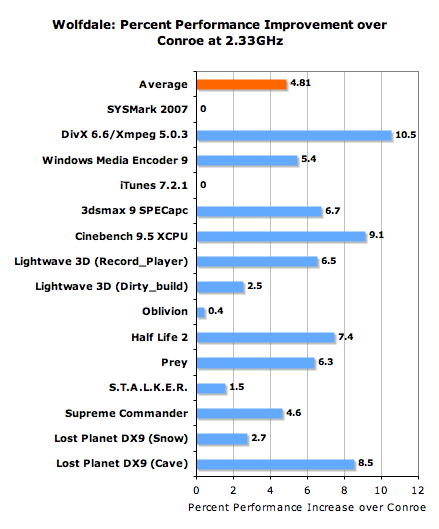The Penryn Preview - Part I: Wolfdale Performance
by Anand Lal Shimpi on August 21, 2007 12:35 PM EST- Posted in
- CPUs
Wolfdale vs. Conroe Performance
We had heard rumors of Intel introducing a faster, lower latency L2 cache in Wolfdale and it appears to be true:
| CPU | ScienceMark L2 Latency (64-byte stride) |
CPU-Z 1.40 (8192KB, 128-byte stride) | CPU-Z 1.40 (8192KB, 64-byte stride) |
| Conroe - 2.33GHz | 13 cycles | 66.87 ns | 15 ns |
| Wolfdale - 2.33GHz | 12 cycles | 48.86 ns | 9.43 ns |
Not only is Wolfdale's L2 cache larger, but it also happens to be slightly faster than its predecessor. Intel has shaved off a single clock cycle from Wolfdale's L2 access time; we're already off to a good start.
If you want a quick glance at what Wolfdale will offer, the chart below will give you just that. We've taken some of our normal CPU benchmarks and ran them on a 2.33GHz Conroe as well as our 2.33GHz Wolfdale, the chart below illustrates percent performance improvement of Wolfdale over Conroe at the same clock speed:

Let's point out the zeros first: SYSMark, iTunes and Oblivion all showed no performance increase from Conroe to Wolfdale. Not all applications will benefit dramatically from the improved cache or architectural improvements and these are examples of some.
The DivX 6.6 test shows a particularly impressive 10.5% increase in performance, especially when you keep in mind that we are running the same DivX test we always run and not an SSE4 optimized benchmark. If you'll remember back to our Intel-sanctioned Penryn preview, with SSE4 enabled Penryn's DivX performance skyrocketed. But this test here shows us that even without SSE4 optimizations, Wolfdale is a healthy 10% faster than Conroe. Windows Media Encoder 9 saw a 5.4% increase in performance, which is still tangible.
Wolfdale also seems to do quite well in 3D rendering apps, giving us 6.7% better performance in 3dsmax 9 and a similar boost in Lightwave. Cinebench performance improved even further at 9.1%.
Gaming performance is a bit of a mixed bag; we saw everything from Oblivion's 0.4% performance improvement to 8.5% under Lost Planet. Wolfdale is good for gaming, but the degree is very title dependent.
On average, Wolfdale ends up being just under 5% faster clock-for-clock than Conroe. Definitely not an earth shattering improvement, but an improvement nonetheless. Focusing in on specific benchmarks, Wolfdale can look even more impressive. Without taking SSE4 performance into account as we don't know how widespread SSE4 applications will be upon its arrival, Wolfdale will simply make competing more difficult for AMD's Phenom, but not impossible.










55 Comments
View All Comments
zsdersw - Tuesday, August 21, 2007 - link
The idiots who predicted a "huge improvement" existed only in your mind, I suspect.. or were never a group of any nominal size to begin with.sprockkets - Wednesday, August 22, 2007 - link
Not really. Search even this site and find stories like "30% improvement over Conroe." They painted Penryn as if it was such a major advance in technology that it would obliterate anything or anyone period had on the planet.sprockkets - Wednesday, August 22, 2007 - link
Yeah, here:http://www.dailytech.com/Intel+Unveils+Penryn+Perf...">Daily Tech Penryn "Benchmarks"
Funny How Intel benchmarked the processors and got "amazing" benefits over the previous generation. Of course they didn't do a clock for clock comparision.
coldpower27 - Thursday, August 23, 2007 - link
Most people were claiming was 5-10% improvement per clock over Conroe, and that is what the data from Anandtech and HKEPC shows, if your talking overall improvements that is trickier as it would depend on what the clockspeed as well, so up to 30%, is not impossible given the right circumstances and depending on what Yorkfield XE tops out at.Performance is not derived from just a clock per clock comparison, you also have to take into account overall clockspeed increases, cache, FSB. Don't expect any corporation to put their processors in any sort of unflattering light, it is in their best interest to make themselves look good, not bad.
zsdersw - Thursday, August 23, 2007 - link
Nowhere in the comments of that story did anyone make any wild performance claims.sprockkets - Friday, August 24, 2007 - link
No, I don't see any inflation here at all.
And if AMD can make a processor run at 3ghz on 90nm, uh, yeah, kinda expect a processor 2 generations down the process line to be able to reach 3.3ghz without issues.
zsdersw - Wednesday, August 22, 2007 - link
Again, not a group of people big enough to be significant.dualathlon - Tuesday, August 21, 2007 - link
Would you please include some wu benchmarks from FAH ?Thanks.
Rebel44 - Tuesday, August 21, 2007 - link
I would also like to see some F@H benchmarks.conquerist - Tuesday, August 21, 2007 - link
1) What HSF was used for the OC? The stock HSF or the Thermalright Ultra 120 Extreme?2) As mentioned before, how does it OC at a higher Vcore?
3) Could you use x264 for the multimedia tests? I suggest this because x264 is open source, and so you can use Intel Compiler 10 or GCC 4.3 with the msse4.1 switch to compile it in SSE4.1! It would be interesting to see how Conrow vs. Penryn SSE3 vs. Penryn SSE4 compare. You can grab a daily tarball of the source at ftp://ftp.videolan.org/pub/videolan/x264/snapshots...">ftp://ftp.videolan.org/pub/videolan/x264/snapshots....